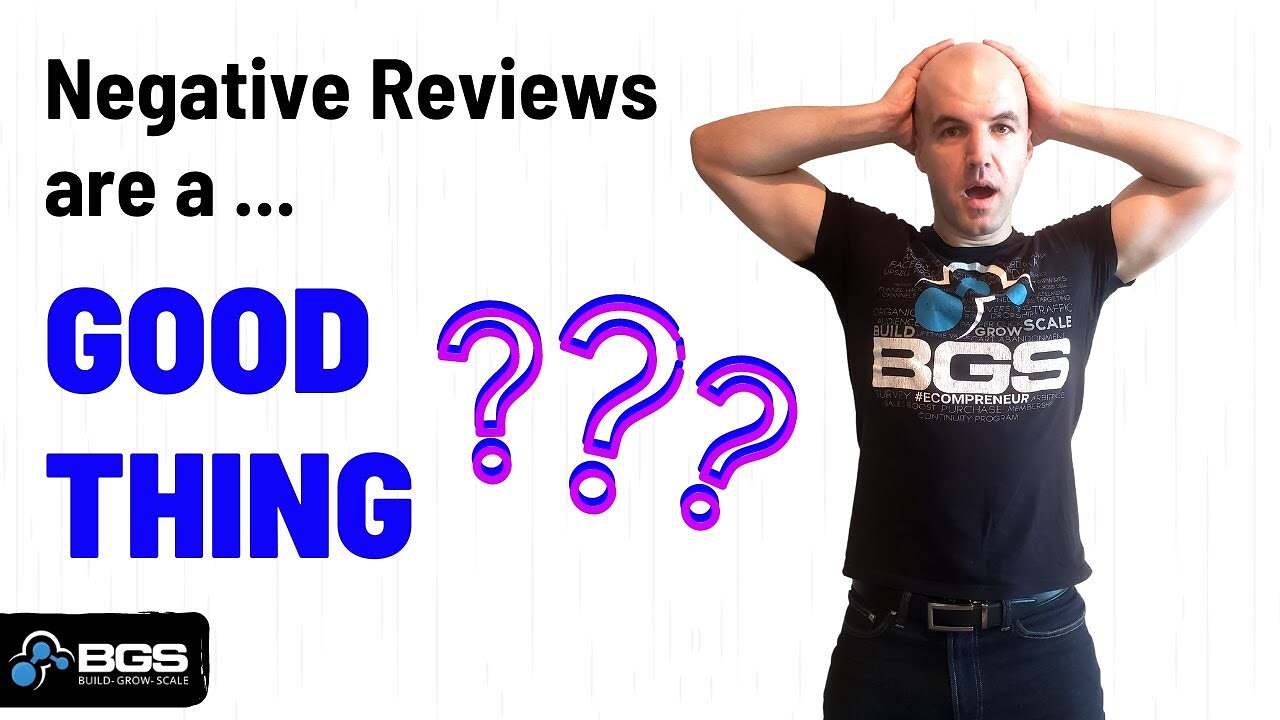Why You Should WELCOME Negative Reviews on Your Ecom Store

Aleksandar Nikoloski | Nov 25, 2021
Reading Time: 6 minutesSee, most people—and you might be one of them—are hiding their negative reviews from the public. Meaning, they will get a negative review through their review app, and they won’t publish it for everybody to see because they think that it will hurt their business. But that couldn’t be further from the truth.
Here’s why …
Everybody knows that you will have negative reviews. Some level of negativity is expected in the reviews, and everybody knows that. And when you hide those negative reviews, people don’t trust you. If all you have is positive reviews (i.e., five stars and four stars), especially if the number of the reviews is great, like hundreds or thousands … that immediately causes some red flags in people’s minds because a certain level of negativity is expected.
Because here’s the truth of things: I don’t care what you’re selling, how awesome your company is, how awesome your product is … You will have negative reviews no matter what. Whether it was because of a customer that didn’t receive their product on time, or they just received a defective product, which will happen (it’s simple statistics; some percentage of the units will always be defective), or whether some customer was simply being a jerk, or had a bad day, or whatever … You will have negative reviews. I guarantee it.
The key with negative reviews is not whether you “have” them, but what you “do” about them. That’s what people care about; that’s what they want to see. In their mind they’re going, “OK, let me see … If something bad happens with this company, will they take care of me?” And when you address your negative reviews, and you publish them, people see, “OK, this person didn’t receive their product for whatever reason, and the support team said, ‘Oh, no worries … we’ll send you a new one!’ … So, if that happens to me, I know I’m covered.” Right? That’s what’s going on in their mind: “OK, if something wrong happens with my order, I’ll be taken care of.” That’s all that they want to see. Does that make sense?
So, that’s why you want to embrace your negative reviews, and here’s what I recommend you do …
Whenever you receive a negative review, respond to it first, and then publish it. If you respond to your negative review and then publish it, it will help your company. If you publish it without responding to it, it will potentially “hurt” your company, because believe it or not, people are looking for those negative reviews. I mean, I do it all the time; I’m sure you’ve done it all the time, trying to see, “OK, what are people complaining about regarding this product, and can I live with this thing that they’re complaining about?” Because, according to Jeff Bezos, reviews are not there to help you make more sales—they’re there to help people make a buying decision.
Think about that one for a second. They’re not there to help you make more sales. They’re there to help your visitors make a buying decision.
What do I mean by this?
Well, for example … Let’s say I’m shopping for some supplements, some greens powder. I’m going to look at the negative reviews and I see a couple of people complaining about the product being too sweet, right? A bunch of one-star negative reviews saying, “This product is too sweet.” Well, guess what? I love sweet things, and when I see that, that’s actually a plus for me. And if I see all of the negative reviews are just about that specific thing, then these reviews help me actually make a buying decision. They “help” me and now I know, “OK, I can live with that,” and I will order that product.
But if that review wasn’t there, that might have not made my decision to buy the product as easy. And also, on the other hand, it might have tricked other people into buying that same product who would have not liked it to begin with, and it would have been a dissatisfied customer … and that would cause customer returns issues, and another negative review, and all of that stuff. Does that make sense? So, having the negative review there actually helped me, who likes sweet things, and also helped the other person, who doesn’t necessarily like sweet things. Because why would you want a customer that wasn’t gonna be happy with your product to begin with, right? That’s just not a good business practice.
So, that’s the number one thing I want you to do: First, respond to the negative reviews, and then push them live so you can help your visitors make a buying decision.
However …
When you do respond to the negative reviews, don’t just say, “Hey, we’re sorry for your problem; email us at support@store.com.” That doesn’t help you much. That’s just a generic response that anybody can read through, even just by looking at a couple of negative reviews. If you say the same thing on every single review, obviously they will just see through it.
What you want to do is … You can still tell them to email you at your support email, but give them specifics on how you will handle that specific issue. For example, let’s say somebody got a defective product, and they give it a negative one-star review. Well, say something like this: “Hey, Jim, we are very sorry that you received a defective product. Don’t worry, we already sent you a replacement. It will arrive in x-number of days. Email our support team for more information.” Something like that. Just give them specifics on how you’re going to solve the issue. That way, when another person looks into this and they’re worried about stuff like that, they’ll be like, “OK, even if that happens, which is possible (it’s simple statistics), I know that they will take care of me.”
Alright, I don’t want to go too long on this. It’s a very simple concept. Just make sure you embrace your negative reviews. Respond to them specifically and push them live, and it will definitely help your store if you do it right. Doing so will not only help your customers make a purchase decision, it will actually increase the trust in your brand and give you credibility, because it tells people, “Hey, we’re not afraid to talk about our flaws. We’re open about them, so you can trust us.” That’s what you’re showing your customers.
So, let’s recap really quick! What do we know so far?
It’s very simple:
-
- First, embrace your negative reviews. Don’t hide them, don’t run away from them. (By the way, you can learn about potential issues with your products that you weren’t aware of just by reading through negative reviews. But first, embrace them.)
-
- Second, respond to them and push them live. (Remember to respond with specifics.)
-
- Third, remember that reviews are not there to help you make more sales … They’re there to help people make a buying decision.
That’s it for this video, I hope you liked it. If you did, make sure you subscribe and hit that notification bell button to find out when we post new videos. And if you have any questions or comments, make sure you drop them in the comments section below.
Lastly if you want our help, just go to workwithbgs.com and fill out a small form. It’s for a free strategy call; we’ll get on the phone and see how we can help you, OK?
Until next time, have a good one and I’ll see you soon.
Frequently Asked Questions
Dealing with negative reviews requires a proactive approach. Firstly, carefully read and understand the feedback to identify any valid points. Respond promptly and constructively, showing empathy and offering solutions to address the customer’s concerns.
When responding to negative reviews in ecommerce, it is important to remain calm and professional. Acknowledge the customer’s concerns and apologize for any negative experience they may have had. Offer a solution or ask for more details to address their specific issues. It is crucial to show empathy and willingness to resolve the problem publicly, demonstrating your commitment to customer satisfaction.
While it is simple to delete a negative review on an ecommerce store, it is important to note that deleting negative reviews should not be the primary focus; instead, focus on addressing the concerns and resolving the issues raised.
About the author
Aleksandar Nikoloski
Aleks is BGS’s Head of Revenue Optimization, an author, and a speaker. He has helped rapid-scale dozens of 6, 7, and multiple 8-figure stores as part of BGS’s Amplify Partnership program. He has gotten one store from $2.6 million a year to $6.7 million a year in 24 months, while another from doing $300k/month to doing over $2 million/month in less than 6 months, just to mention a few. The BGS team calls him the “Site Whisperer” because of his ability to find site nuances that derail the customers’ journey and cause purchase friction. Extremely meticulous and analytical, he credits all of this success to data and accurate interpretation of that data, as well as his ability to implement and test new ideas almost immediately.







